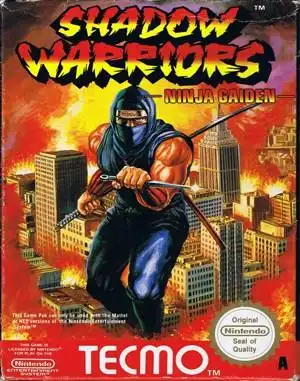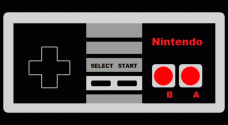Stepping back into the late 80s, there were a few names that struck a mix of awe and pure, unadulterated terror into the hearts of young gamers. One of those names, whispered with a blend of respect and dread, was Ninja Gaiden. For many, this Tecmo classic on the Nintendo Entertainment System wasn't just a game; it was a rite of passage, a test of patience, and a masterclass in 8-bit ninja action.
Released in North America in March 1989, Ninja Gaiden arrived hot on the heels of its arcade counterpart (a beat 'em up, interestingly, unlike the NES platformer). But it was the home console version that truly cemented the legend of Ryu Hayabusa and his brutal quest. This wasn't just another side-scrolling action game; it was something different, something that pushed the boundaries of what we expected from our little gray boxes.
The Legend Begins: Ryu's Quest
The story of Ninja Gaiden was surprisingly deep for its time, especially for an 8-bit title. We follow Ryu Hayabusa, a young ninja whose father is seemingly killed in a duel. A cryptic letter from his dad sends Ryu to America, kicking off a globe-trotting adventure involving ancient demon statues, a sinister cult leader named Jaquio, and a mysterious woman named Irene Lew.
What really set the scene, though, were the cinematic cutscenes. Dubbed "Tecmo Theater," these static-image sequences with scrolling text felt revolutionary. They built a narrative, introduced characters, and added a layer of drama that most games of the era simply didn't have. It made you care about Ryu's journey beyond just the next platforming challenge.
Sword, Shuriken, and Wall Cling: Core Gameplay
At its heart, Ninja Gaiden is a side-scrolling action-platformer. You control Ryu with tight, responsive controls. Your primary weapon is your trusty Dragon Sword, perfect for slicing through the endless parade of demons, soldiers, and bizarre creatures Tecmo threw at you.
But Ryu wasn't just a slasher; he was a ninja! The game introduced iconic movement mechanics like the wall-climb/cling, allowing Ryu to scale walls and reach higher platforms, adding verticality to the levels. You also collected 'Ninja Arts' – powerful sub-weapons like the classic shuriken, the devastating Fire Wheel, the defensive Fire Shield, and the always-useful Jump & Slash. Managing your limited spiritual power (ammo) for these arts was key to survival.
The Brutal Beauty of Difficulty
Let's be honest: you can't talk about Ninja Gaiden without talking about its difficulty. This game helped define the term "Nintendo Hard." It wasn't just challenging; at times, it felt downright unfair.
- Enemy Placement: Enemies seemed strategically placed to knock you into pits or off platforms.
- Respawn: The infamous instant enemy respawn when you scrolled back even slightly was a constant source of frustration. Those birds, man. Those birds.
- Difficulty Spikes: Just when you thought you had a handle on things, the game would crank up the heat, often dramatically in later acts.
- Bosses: Boss fights were tough, pattern-based encounters that required precision and often, a lot of trial and error.
And then there's the final act. Losing to the final boss meant being sent all the way back to the start of Act 6. This intentional design choice felt like a cruel joke after hours of struggle, but it also made finally conquering the game an almost mythical achievement. Thankfully, the NES version offered unlimited continues, a small mercy in a world of pain.
Despite the rage quits and the controller-throwing moments, the difficulty was part of the charm. It demanded mastery, precision, and perseverance. Beating Ninja Gaiden felt like earning a badge of honor.
Tecmo Theater: Cinematic Storytelling
As mentioned, the cutscenes were a game-changer. While simple by today's standards, the anime-inspired visuals and dramatic pacing were incredibly effective in 1989. They broke up the intense gameplay, advanced the plot, and gave context to Ryu's seemingly relentless battle against evil. It was a glimpse into the future of video game storytelling.
Beyond the 8-Bit Challenge: Legacy and How to Play Today
The success of the original Ninja Gaiden spawned two excellent NES sequels, continuing Ryu's adventures. The franchise later saw entries on other classic systems like the Super NES (via the Ninja Gaiden Trilogy compilation, though with some changes), Game Gear, and even PC Engine.
In the modern era, the series was successfully revived with a critically acclaimed 3D action series starting on the Xbox in 2004. Ryu Hayabusa also became a staple character in the Dead or Alive fighting game series and appeared in various crossovers.
If you're feeling nostalgic or want to experience the original challenge, you have options:
- Compilations: The
Ninja Gaiden: Master Collectionreleased in 2021 includes the modern 3D titles. For the classic NES experience, you might need to look for the SNESNinja Gaiden Trilogyon older hardware or emulation platforms. - Digital Releases: The original NES game has appeared on Nintendo's Virtual Console services over the years and is currently available on Nintendo Switch Online for subscribers.
- Emulation: The PC Engine port is also available via emulation. Be sure to check out legitimate sources like GOG.com or explore historical archives like Archive.org for compatible emulators like DOSBox for any old PC ports you might find.
Whether you played it back in the day or are curious about the legend, Ninja Gaiden remains a landmark title. It's a game that tested your limits, told a story with flair, and delivered pure, unadulterated 8-bit ninja action. Just try not to throw your controller when those birds show up.
FAQ
Q: Is Ninja Gaiden on NES really that hard? A: Yes, it is widely considered one of the most difficult games on the NES, often cited as an example of "Nintendo Hard" due to challenging enemy placement, instant respawns, and demanding platforming.
Q: What are Ninja Arts? A: Ninja Arts are special sub-weapons or techniques Ryu can collect and use by expending spiritual power. Examples include the shuriken, Fire Wheel, and Fire Shield.
Q: Are the cutscenes in Ninja Gaiden on NES animated? A: The cutscenes, known as "Tecmo Theater," are primarily static images with scrolling text, but they use camera techniques and dramatic art to tell the story effectively, feeling very cinematic for the time.
Q: Can I play the original Ninja Gaiden today?
A: Yes, the NES version is available on Nintendo Switch Online for subscribers. The SNES compilation Ninja Gaiden Trilogy can be played via emulation or on original hardware, and the modern Master Collection is available on current platforms.


